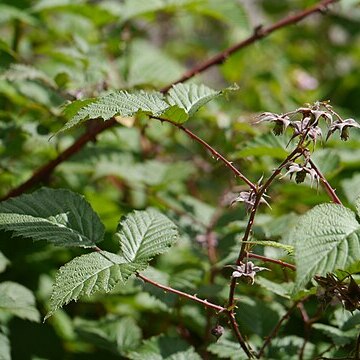Shrubs. Branchlets brownish to reddish brown, initially pubescent, gradually glabrescent, with few prickles. Leaves imparipinnate, 3-foliolate, rarely 5-foliolate; petiole 3–5 cm, with rachis pubescent, with sparse, minute prickles; stipules linear or linear-lanceolate, 5–8 mm, soft hairy; blade of leaflets ovate or broadly ovate, rarely ovate-lanceolate, 2.5–6 × 2–5 cm, abaxially densely persistent tomentose, adaxially pubescent, glabrescent, base subrounded to shallowly cordate, margin irregularly incised rough sharp doubly serrate, apex acute to acuminate. Inflorescences corymbose, several flowered. Pedicel 1.5–3.5 cm, soft hairy. Flowers 1.5–2 cm in diam. Calyx to ca. 1.5 cm, abaxially pubescent; tube pelviform; sepals erect after anthesis, narrowly ovate to ovate-lanceolate, 1–1.2 cm × 3–6 mm, margin tomentose, apex long acuminate or caudate. Petals pink, ovate, 7–10 × 4–6 mm, shorter than sepals, base shortly clawed, apex slightly incised or entire. Stamens many. Pistils somewhat shorter than or nearly as long as stamens; ovary sericeous, soft hairy. Aggregate fruit black, ovoid-globose.
More
A shrub. The branches are brown and have hairs when young. There are only a few prickles. The leaves have leaflets along the stalk and one at the end. There are 3 and occasionally 5 leaflets. The leaflets are oval or sword shaped and 3-6 cm long by 2-5 cm wide. There are several flowers in a group and they are up to 2 cm across. The petals are pink. The fruit are aggregate and black.
An understorey shrub in fir and oak forests; at elevations from 2,400-3,000 metres. Forested slopes, thickets and logged lands; at elevations from 2,700-3,200 metres in western China.
More
It is a temperate plant. In western China it grows between 3,000-3,200 m above sea level. In Yunnan.
Can be grown by cuttings, seedlings or suckers. Seeds needs stratification.

